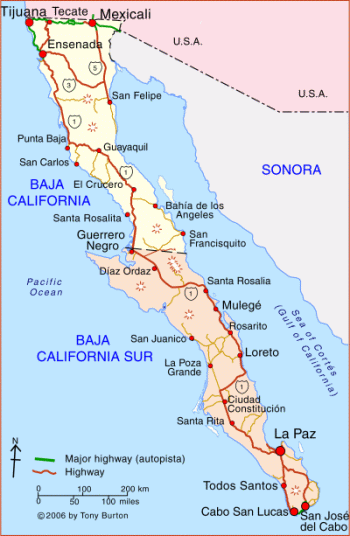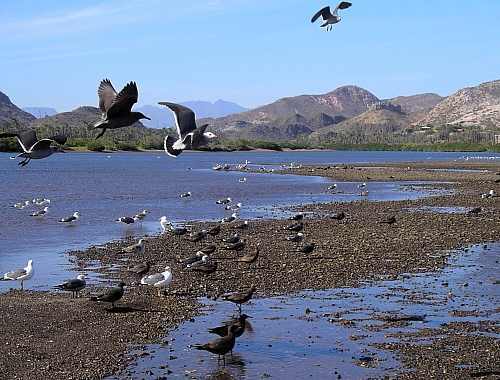The rugged Baja California peninsula and the Sea of Cortez, or Gulf of California, have been bewitching hardy visitors for decades. Some of the early fans were John Steinbeck and Earl Stanley Gardner, who took time out from Perry Mason to produce a magnificent photo book on the Sea of Cortez and its villages.
Until the 1973 completion of Mexico Highway One, which opened up travel to standard vehicles, most northern visitors arrived by boat or in expensive expeditions by charter and private plane. Today, oases like Loreto and Mulege, long favorites of fisherfolk, are open to anyone with a car or the price of a commercial plane ticket, but the eastern Baja ambience hasn’t noticeably changed since my first trips in the ‘60s. It still attracts campers, hikers, backpackers and others seeking serene days and nights without discos.

The 1,059-mile highway zigzags back and forth across the predominantly desert peninsula, from Tijuana to Cabo San Lucas, and has brought considerable growth to remote settlements. Aero California serves Loreto from Los Angeles, California, and from several Mexican cities, with one flight a day in and one out. Considering that, the airport facility looks a bit over-built, and it is. There was a time when FONATUR, the Mexican tourist development agency, planned a grand resort at Nopoló, just south of Loreto, and built the airport to match.
The resort is there, complete with golf course and international tennis center, condos, houses and hotels, paved streets surrounded by manicured lawns and plantings — but almost no people. On an afternoon drive through Nopoló during the Christmas season, we saw perhaps half a dozen people, and a huge number of obviously empty residences. The locals say Fonatur just lost interest after putting in the infrastructure. That could have been because Loreto is, after Chicago, the windiest place I’ve ever been.
‘Is it always this windy?’ I asked a man at the airport.
‘Oh no, señora. Only from November to March. Then the wind stops and it’s like an oven.’
Possibly not the best climatic choice for a luxury resort, but Loreto’s an attractive and interesting town of about 9,000, with a helpful tourist office, a small museum focusing on mission history, an extremely popular self-serve pancake restaurant with outdoor tables on the plaza, a Bancomer, and some very good seafood restaurants. The restaurant Sin Nombre on the malecon, run by Americans, caters to tourists with generous helpings of not-too-spicy Mexican and U.S. fare, and a large-screen satellite TV. Loreto is also where you find rental jeeps, in an office on the malecon about two blocks north of Sin Nombre.

Eighty-four miles north (about two hours) is Mulege, a bit hillier, a bit more sheltered, a bit shabbier, never the recipient of government favors, and probably the better for that. The tiny private planes still land at the landing strip of the luxurious Hotel Serenidad, just south of town.
The Serenidad is a magnet for isolated Baja residents seeking a sociability fix, and famed throughout the region for its Saturday night pig roasts and dancing, and for its spacious but cozy bar, where visitors and area residents mingle for cocktails and TV news before dinner and conversation or chess games after. Couches flanking the fireplace were the sought-after seating during the nippy holiday season.
The Serenidad has a few conventional rooms in a wing near the swimming pool, but most guests ask for the outlying clustered cottages with verandas, (and some with two bedrooms) where the help piles up the piñon wood nightly for the very necessary in-room fire. It’s the kind of place you keep returning to, obviously, and many of the verandas spilled over with large family groups, playing table games, admiring the lazy Mulege river and the ducks that bob on it, or watching the shiny little planes land.
The town offers pretty fair souvenir shopping, a laundromat, a dive shop run by an American woman who arranges trips, several pleasant-looking small hotels and guest cottages, a few nice restaurants and a couple of U.S.-style markets. Most places accept credit cards, which is a great relief when you learn to your horror that there’s no bank or ATM machine in the town.
Pelicans fill the skies over the beaches that scallop the shoreline between Mulege and Loreto, and the beach settlements are a tribute to sportsmanship and stewardship. Visitors have constructed toilets and trash disposal bins, and make a point of maintenance, both on the beach and at the occasional secluded hot spring hidden among the rocks and brush. Clearly, the visitors think of the semi-permanent camps as their vacation homes. There are also some housing developments, both detached homes and condos, on the Gulf beaches.
